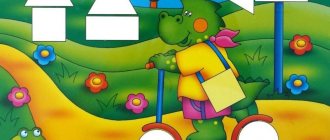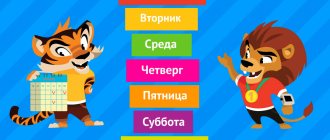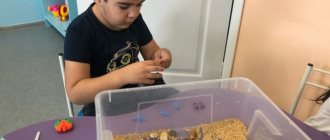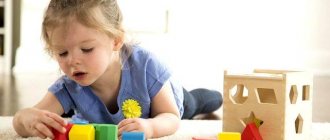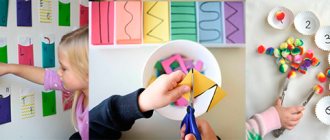MAGAZINE Preschooler.RF
Card index of games and play exercises for the development of thinking in preschool children with mental retardationAnanyeva E.V. teacher - defectologist MKDOU d/m 428
Children with mental retardation have a delayed rate of formation of mental operations, which in the future will negatively affect their learning at school. It will be difficult for such a child to master the general education school curriculum. Therefore, it is very important that kindergarten teachers, as well as parents, begin to work as early as possible on the development of thinking in children with mental retardation. In preschool childhood, the leading activity for the comprehensive development of a child is play. Therefore, this consultation presents a selection of games aimed at developing thinking in children with mental retardation.
Thinking is a socially conditioned mental process that is inextricably linked with speech. In the process of mental activity, certain techniques and operations are developed (analysis, synthesis, comparison, generalization, specification).
There are three types of thinking:
- visual-effective (cognition through the manipulation of objects)
- visual-figurative (cognition through representations of objects, phenomena)
- verbal-logical (cognition using concepts, words, reasoning)
№
| Game and its contents | Leading thinkers operations | |
| 1 | Game “Find the same toy” Instructions: children are asked to find identical toys among those offered (arrange the toys in a row). Find identical toys in a group. We need to invite children to explain why they think that the toys are the same. | Comparison |
| 2 | Game "Wonderful bag" Instructions: Place several items in a linen bag. For example: 1 spool, button, rubber toy, 2 spoons. The child is asked to determine by touch what these things are, describe them and think whether any of them are the same. | Comparison |
| 3 | Game "Butterfly and Flower" Instructions: Butterflies want to find their flowers - to sit on a flower so that they cannot be seen and no one can catch them. Paying attention to the fact that the color of the butterfly and the flower match. | Comparison |
| 4 4 | Game "Geometric Mosaic" Children are asked to tell what geometric shapes the image is made of, how many there are and what color. Then lay out the same pictures from a set of geometric shapes, first by overlaying them on a card, then complicating the task: next to the picture, and then from memory. | Comparison |
| 5 | Game "Pyramid" (large) Tumbler pyramid with bright rings. Instructions: you need to string the rings onto the rod in any order, and then in ascending or descending order of their diameter or color. | Synthesis |
| 6 | Game "Mailbox" A box with figures is placed in front of the child; the figures are taken out. The teacher takes one of the figures and shows its base. He outlines the corresponding slot and lowers the figure into it. With a gesture he invites the child to continue working. Instructions: “Put all the pieces into the box.” | Synthesis |
| 7 | Game “What the artist drew” Instructions: Children are given natural objects, selected according to lexical topics (fruits, vegetables) or in random order. Each child talks about the object, highlighting its properties and characteristics. Initially, the object is named, then its characteristics are listed, and the children guess the object. | Synthesis |
| 8 | Game "What's missing here?" The child is offered object toys. Instructions: Look carefully at the four object toys and determine which object is superfluous and why. | Analysis |
| 99 | Game "Alternation" Invite your child to draw, color or string beads. Please note that the beads must alternate in a certain sequence. In this way you can lay out a fence of multi-colored sticks, etc. | Analysis |
| 9 10 | Game “Guess by Description” An adult offers to guess what (what vegetable, animal, toy) he is talking about and gives a description of this item. For example: This is a vegetable. It is red, round, juicy (tomato). If the child finds it difficult to answer, pictures with various vegetables are laid out in front of him, and he finds the one he needs. | Analysis |
| 11 | Game “Guessing Fables” An adult talks about something, including several fables in his story. The child must notice and explain why this does not happen. Example: Here's what I want to tell you. Just yesterday - I was walking along the road, the sun was shining, it was dark, the blue leaves were rustling under my feet. And suddenly a dog jumps out from around the corner and growls at me: “Ku-ka-re-ku!” - and she already pointed her horns. I got scared and ran away. Would you be scared? Yesterday I was walking through the forest. Cars are driving around, traffic lights are blinking. Suddenly I see a mushroom. It grows on a branch. Hid among the green leaves. I jumped up and tore it off. I came to the river. I look - a fish is sitting on the shore, its legs crossed and chewing a sausage. I approached, and she jumped into the water and swam away. | Analysis |
| 12 | Game “Nonsense” Offer your child drawings that contain some contradictions, inconsistencies, or violations in the behavior of the characters. Ask your child to find mistakes and inaccuracies and explain his answer. Ask how it really happens. | Analysis |
| 13 | Game “Words in Reverse” Offer your child the game “I will say the word, and you will also say it, only in reverse, for example, big - small.” You can use the following pairs of words: cheerful - sad, fast - slow, empty - full, smart - stupid, hardworking - lazy, strong - weak, heavy - light, cowardly - brave, white - black, hard - soft, rough - smooth and etc. | Analysis |
| 14 | Game “True - False” Name some situation and throw the ball to the child. The child must catch the ball if the named situation occurs, and if not, then the ball must be returned. You can offer different situations: dad went to work; a train flies across the sky; the cat wants to eat; the postman brought a letter; salted apple; the house went for a walk; glass shoes, etc. | Analysis |
| 15 | Game "Pyramid" (small) The “bee” pyramid consists of 3 parts. Instructions: Look carefully and think about the order in which you need to string the rings onto the rod in order for a “bee” to appear. | Analysis |
| 16 | Game "Traffic Light" The teacher introduces the children to the traffic light and shows how the light turns on. They remember what color they use and what actions they do. Instructions: Look carefully at what color the traffic light is, at what color of the traffic light you need to move, get ready, go. | Analysis |
| 17 | Game "Cut pictures" The game consists of asking the child to assemble a picture from parts. No special preparation of material is required for this game; you can cut the cards into pieces. You can complicate the game by first cutting the picture into 3-4 parts, then 6-7 parts, etc. | Analysis |
| 18 | Game "Puzzles with matches" Take a few sticks or matches and put them together to create a schematic representation of an object. After this, invite the child to mentally rearrange one or more matches so as to turn this image into another or somehow change it. | Analysis |
| 19 | Games "Pythagoras", "Columbus Egg" "Vietnamese game" "Tangram" "Magic Circle". | Analysis |
| 20 | Game "Pick a Pattern" Pieces are cut out from the picture with a certain pattern. It is necessary to find these pieces among those offered to the child. It is necessary to draw the child’s attention to the fact that not just any pieces can be placed in the places of the cut out rectangles, but only those that correspond to the pattern of the picture. To do this, you need to carefully compare the pattern elements in the main drawing and the cut out pieces. Games of this type become more complex by increasing the number of elements that need to be compared. | Analysis |
| 21 | Game “Pick the right fragment” This game is similar to the previous one. Only here the child is offered pictures not with a specific pattern, but plot illustrations. The illustrations also have cut out pieces. It is necessary to find these pieces among those offered to the child and “repair” the picture. | Analysis |
| 22 | Game “Who loves what?” Pictures with images of animals and food for these animals are selected. Pictures of animals and separate pictures of food are laid out in front of the child, and they are offered to “feed” everyone. | Analysis |
| 23 | Game "Zoo" The teacher builds a “zoo” and places animals in one carriage and birds in the other. Instructions: Look carefully, think and find a house for animals and a house for birds. Put everyone in their place. | Generalization |
| 24 | Game “Name in One Word” The child is read the words and asked to name them in one word. For example: fox, hare, bear, wolf - wild animals; lemon, apple, banana, plum - fruits. For older children, you can modify the game by giving a generalizing word and asking them to name specific objects related to the generalizing word. Transport - ..., birds - ... | Generalization |
| 25 | Game "Mushroom Picking" The teacher places mushrooms of three colors on the floor (mushroom caps are red, yellow, brown), takes three baskets - red, yellow, brown. Instructions: In the basket you need to put mushrooms of the same color as the color of the basket. | Generalization |
| 26 | Game "Fourth wheel" Prepare objects or pictures that are related to groups such as toys, dishes, tools, fish, fruits, vegetables, berries, drinks, food, clothing, shoes, hats, furniture, transport, trees, animals, birds, electrical appliances. Choose 4 pictures from one group and one picture from any other group. Place them in a row on the table. Thus, it turns out that the main part of the pictures has one common feature, which allows them to be combined into one group. One picture does not have this feature and therefore differs from the rest. She is superfluous. The child needs to carefully examine all the pictures, find the odd one and explain his decision. | Generalization |
| 27 | Lotto “Color and Shape” To consolidate their knowledge of geometric shapes, children are given cards with images of geometric shapes. The presenter shows small cards with objects similar to certain geometric shapes. Children find objects that match their geometric shapes and place them on their cards. To reinforce primary colors and shades, color cards are used, where the child selects objects of the corresponding color. | Generalization |
| 28 | Game “Place the objects in their places” The teacher arranges the objects, the children examine them. Instructions: Children are asked to find and place an object that looks like a triangle, name the color of the object (for example: a pyramid looks like a triangle, red, etc.). | Generalization |
| 29 | Game “Find the extra picture” Select a series of pictures, among which three pictures can be combined into a group according to some common characteristic, and the fourth is extra. Invite your child to find the extra picture. Ask why he thinks this way. How similar are the pictures he left? | Generalization |
| 30 | Game “Find the extra word” Read a series of words to your child. Offer to determine which word is “extra.” Examples: Old, decrepit, small, dilapidated; Brave, angry, daring, daring; Apple, plum, cucumber, pear; Milk, cottage cheese, sour cream, bread; Hour, minute, summer, second; Spoon, plate, pan, bag; Dress, sweater, hat, shirt; Soap, broom, toothpaste, shampoo; Birch, oak, pine, strawberry; Book, TV, radio, tape recorder. | Generalization |
| < Previous | Next > |
Techniques to help you remember
If your child has difficulty remembering the words you told him, give him paper and colored pencils. Offer to make a drawing for each word that would help him remember these words later.
The same can be done when memorizing phrases. The child chooses what and how he will draw. The main thing is that this will help him later remember what he read.
For example, name seven phrases:
- The boy is cold.
- The girl is crying.
- Dad is angry.
- Grandma is resting.
- Mom is reading.
- Children are walking.
- It's time to sleep.
For each phrase, the child makes a drawing (diagram). After this, ask him to accurately reproduce all the phrases. If difficulties arise, please help with a hint.
The next day, ask your child to repeat the phrases again using his drawings. Notice if the pictures help him. If he remembers 6-7 phrases - very good.
Games of children with delayed psycho-speech development: features and examples
At first glance, it seems that play for any child is a completely natural state that does not require any effort on the part of an adult and is given to the child easily and simply. But can everyone play? And are there any peculiarities in the play activity of a child with delayed psycho-speech development?
We talked about this with Ekaterina Cherkaeva, a pediatric neurologist, a specialist in Tomatis therapy and micropolarization, the founder of the Kuzbass Neuro medical center for children with neurological diseases.
What is ZPRR?
Delayed psychospeech development (DSRD) is a consequence of deviations in the formation of the brain and central nervous system.
Children with developmental disabilities have problems with attention and concentration. It is difficult to teach them something new. Gaming activity is quite intermittent and inconsistent. They “jump” from one thing to another, don’t know what to take on, and absolutely cannot do one thing for a long time.
Any extraneous stimuli instantly distracts the child and switches his attention. Such a child quickly gets tired during strenuous activity, immediately becomes hyperactive, or his attention evaporates.
What are the features of the cognitive development of children with mental retardation disorders?
Children with mental and speech delays do not really like to explore the world. They have problems with attention, memory, concentration and volition. Often their gaming activity is higher than their cognitive one.
For example, a schoolchild will take out his toys during class. It is very difficult for him to sit and study, it is not interesting. A two-year-old child with mental retardation will mainly push cars. He will not want to assemble even simple puzzles from two components. Such children will always lag behind in play and cognitive activities.
How do the play activities of children with mental retardation disorders differ from those of normal children?
In principle, the play activity of a child with mental retardation proceeds in the same stages as that of ordinary children. But much slower.
For example, an ordinary six-year-old child can already develop a role-playing game. Let's say you play doctor and patient with your girlfriend. At the same time, the participation of an adult is not necessary - the child himself can say: “Let me start treating you!” The kids themselves will come up with a plot, assign roles, and so on.
Can children with mental retardation develop their own games or do they need help with this?
A 6-year-old child with delayed psycho-speech development can use object-based play. For example, cutting vegetables. Without the help of an adult, such a child may not understand how to play something with a role-playing role: daughter-mother, doctor-patient, seller-buyer, and so on.
He can only do this if an adult sits down next to him and says: “Let me be your patient, and you are a doctor and will treat me.” Perhaps a child with mild mental retardation will understand what to do with objects for play - he will take a hammer, a phonendoscope, knock, listen. But usually this is not enough for his gaming activities; he is bored. He will want to go back to cars and Legos.
Usually at the reception I ask parents: if your child is left alone, what will he play? Often, if gaming activity is one-sided and boring, one can already suspect a delay in psycho-speech development. For example, if the baby is two and a half years old, and he only rolls cars and is not interested in anything else. He does not sort animals and objects, does not assemble puzzles. If the child’s play activity is scarce, developmental delay can already be assumed.
How to play with a child who has been diagnosed with SPD? Main features, subtleties, what you need to remember?
All therapy by speech pathologists, psychologists and neuropsychologists takes place in a playful way for children with mental retardation disorders. The child himself, due to reduced cognitive, intellectual and emotional activity, may not perceive many games. But in the company of adults he can play.
Normally, a six-year-old child can find a toy partner to play with. That is, you don’t even always need another child or adult for this. But a child with mental retardation usually cannot do this.
Children with mental retardation disorders have underlying impairments: for example, auditory attention. We also often find motor clumsiness: such guys cannot repeat any simple action. It needs to be planned, presented and repeated. Their visual analyzer functions well. Therefore, defectologists often use pictures when working with such children.
Give specific examples of games for children with developmental disabilities?
For example, you can use games for auditory attention with a trick. This is a great way to improve visual attention if a child has difficulty keeping a line with his eyes.
The Hedgehog Letter game is aimed at developing visual attention.
- For an adult: the child’s task is to read the phrase by assembling the letters along the arrow.
- In the top field there are 3 arrows showing the tracking path.
The bottom field is filled with letters. If you collect the letters along the trajectory indicated by the arrows, you will get an encrypted phrase.
- To read the text following the arrow, the child needs to mentally combine the two fields.
- If this is difficult to do, have the child draw exactly the same arrows on the field with letters and, following their direction, read the phrase.
- To a child: “One day the Hedgehog was walking through the forest and met a lot of letters on his way. From them he made a wish for you. To read it, follow the paths along which the Hedgehog walked (they are indicated by arrows), and collect the letters exactly in that sequence.”
Do you want your child to listen more carefully and correct his own reservations? And for preschoolers, this is an excellent skill of auditory attention, which will also be useful at school: writing dictations, listening to assignments from the teacher.
For preschoolers and schoolchildren, listening games with a trick are important.
See for yourself how difficult it is.
- Simple: There were tomatoes growing on the palm tree.
- Middle: Two brothers Olya and Dima went for a walk in the forest.
- Difficult: A hare ran out onto the road, sat down, looked around and, waving his long fluffy tail, ran on.
Of course, a child from 5 years old can already understand the catch, in some cases earlier. But the main age for testing is from 6 years. You start with simple ones, you can compose yourself.
Let us also add that the support in the game should be an adult, and not objects, since it is difficult for children with developmental disabilities to build associative connections in their heads between, say, a saucepan and playing a cook or a telephone and the ability to use it to call a doctor or firefighters.
It is important to pay children's attention more to the storyline than to performing certain actions, otherwise the whole game may simply come down to a meaningless, repeated repetition of the same movement.
Children with developmental disabilities find it difficult to fantasize or give objects any properties that are unusual for them. So the spoon for them serves exclusively for food and cannot in any way play the role of a drumstick without prompting from an adult.
The game is led by an adult - the active participation of children and improvisation in such games are, as a rule, impossible.
The key to success in organizing games for children with developmental disabilities is the use of theatrical and role-playing entertainment.
They are the ones who will become a reliable support and support in working with such kids and solving the main task - teaching them to play independently. Share on social networks
Games on lexical topics for children with mental retardation 5-7 years old.
Games on lexical topics for children with mental retardation 5-7 years old.
Topics: VEGETABLES, FRUITS
1. “Pick a pair”
— teach children to compare objects by shape, color, size, taste.
2.”Find by description
“- teach to find objects by characteristics (color, shape, size)
3.”Choose by shape
“- consolidate the ability to classify objects and analyze shape.
4. "Fun account"
- practice counting, coordinate a noun and a numeral (one apple, two apples, three apples, five apples, six apples.)
5. "Wonderful bag"
- recognize objects by touch, develop tactile perception, describe a vegetable or fruit.
6. “Describe, we will guess
“- learn to describe objects (vegetables, fruits, find them by description.
Topic: MUSHROOMS
1. "Edible and inedible"
— learn to group objects, consolidate knowledge about mushrooms.
2.”What has changed?
“- develop attention, memory (there is no first mushroom, there is no third, etc.)
3. “Call me kindly”
- fix the count (one boletus, three chanterelles, six honey mushrooms.)
4. "Rank the mushrooms by size"
- develop the eye, the concept of “size”.
Theme: TREES
1. “One is many”
- use the plural (one birch - many birches, one oak - many oaks.)
2. “Which one?”
- develop visual perception, consolidate the concept of “size,” consolidate ordinal counting, arrange trees by height and trunk thickness.
Topic: TOYS
1. "Funny counting!
- combine a noun with a numeral.
2. "Find a toy"
- learn to navigate in space.
3. “What is this shape?”
- learn to analyze the shape of an object.
4. “Where is the toy?
“- use prepositions: behind, between, before, about, on the right, on the left
5.”What does it consist of?
“- learn to analyze the shape of an object, consolidate knowledge of geometric shapes.
Topic: CLOTHING. SHOES.
1. "Name the parts of clothes (shoes)", "Add the whole"
- reinforce the concepts of “part and whole”
2. “What for whom?”
- learn to group objects.
3.”Clothing store
“- fix the count, color, size, shape.
4. "What's where?"
- practice orientation in space (between, about, left, right, above, below)
5. “Decorate the mittens”
- develop the ability to create a pattern of geometric shapes.
6. “Help the girls pick out a scarf and boots.”
Topic: FURNITURE
1. "What's extra?"
- develop attention and logical thinking.
2. “Name the parts of the furniture”
— consolidate the concepts of “part and whole.”
3.”What comes in this shape?
“- consolidate the ability to analyze the shape of an object.
Topic: TABLEWARE
1. "What for what?"
- learn to classify objects.
2. "The Fourth Wheel"
“- develop attention, consolidate knowledge about dishes.
3. "Fun account"
- practice counting, combine nouns and numerals.
4. "Multi-colored cups"
- ordinal counting (red cup is the first, yellow is the second, blue is the tenth)
